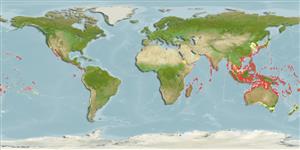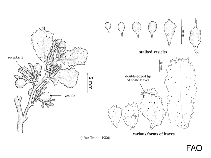Turbinaria ornata (Turner) J. Agardh
Crowded sea bell| Native range | All suitable habitat | Point map | Year 2050 |

|
| This map was computer-generated and has not yet been reviewed. |
| Turbinaria ornata AquaMaps Data sources: GBIF OBIS |
Google image | No image available for this species;
drawing shows typical species in Sargassaceae.
Classification / Names आम नाम | उपशब्द | CoL | ITIS | WoRMS
Phaeophyceae | Fucales | Sargassaceae
Environment: milieu / climate zone / गहराई सीमा / distribution range पारिस्थितिकी
; गहराई सीमा 0 - 53 m (संदर्भ 102117). Tropical
Distribution देश | ऐफ ऐ ओ क्षेत्र | Ecosystems | संयोग | भूमिका
Indo-Pacific: from Eritrea to South Africa to Madagascar and India, including Western Australia, Andaman, Nicobar and Christmas Islands and from China to the South China Sea, Australia, including Federated States of Micronesia, Fiji, and French Polynesia; from east to Chile, including American Samoa, Samoan Archipelago, Cook and Hawaiian Islands.
Length at first maturity / आकार / Weight / Age
परिपक्व अवधि: Lm ? range ? - ? cm
Short description आकृति विज्ञान
Life cycle and mating behavior परिपक्व अवधि | पुनरुत्पत्ति | मछलीऔ का अंडे देना | Eggs | Fecundity | Larvae
Main reference
संदर्भ | संयोजक | सहयोगीयो
Guiry, M.D. and G.M. Guiry. 2009. (संदर्भ 80701)
IUCN Red List Status
(संदर्भ 130435: Version 2024-2)
CITES status (संदर्भ 108899)
CMS (संदर्भ 116361)
Threat to humans
Human uses
मात्स्यिकी: व्यापारिक
| FishSource |
साधन
अधिक जानकारी
संघटक आहार
आहार खपत
परभक्षी
परिपक्व अवधि
Fecundity
मछलीऔ का अंडे देना
Eggs
Egg development
Larvae
इंटरनेट स्रोत
BHL | BOLD Systems | CISTI | DiscoverLife | FAO(Publication : search) | Fishipedia | GenBank (genome, nucleotide) | GloBI | Gomexsi | Google Books | Google Scholar | Google | PubMed | AlgaeBase | Tree of Life | Wikipedia (Go, खोज) | Zoological Record



